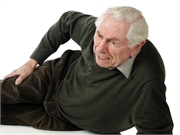Parkinson's Ups the Odds for Dangerous Falls, But Prevention Is Key
By E.J. MundellHealthDay Reporter

WEDNESDAY, Sept. 16, 2020 (HealthDay News) -- A major cause of falls in older people is more common among Parkinson's patients, and monitoring for the condition might lower patients' risks, new research shows.
Ever feel dizzy and lightheaded when you suddenly stand up? It's caused by a sudden drop in blood pressure -- a condition doctors call orthostatic hypotension and it can lead sometimes to fainting and falling down.
New research shows that people with Parkinson's disease had double the odds of folks without the condition to develop orthostatic hypotension, and are at heightened odds of dangerous falls as a result.
But, "if we can monitor people's blood pressure to detect this condition, we could potentially control these blood pressure drops and prevent some of the falls that can be so damaging for people with Parkinson's," explained the study's lead author, Dr. Alessandra Fanciulli. She's with the Medical University of Innsbruck, Austria.
One U.S. expert unconnected to the study agreed.
Falls are "an important problem in Parkinson's disease, and often a neglected one," said Dr. AlessandroDiRocco. He directs Northwell Health's Movement Disorders Program in Great Neck, NY. "Problems with blood pressure control, and especially episodes of low blood pressure, often associated with changes in position, from sitting or lying to standing, are common in Parkinson's disease, and not infrequently cause syncope, or faint episodes."
According to Di Rocco, the frequency and severity of falls can increase along with the severity of Parkinson's, with result often being "fractures and other traumatic injuries."
Too often, physicians who treat Parkinson's patients underestimate the role of orthostatic hypotension in falls, and fail to provide proper drug treatment, Di Rocco added.
The new study was published Sept 16 in Neurology and included 173 people with Parkinson's disease who'd been referred to doctors for testing for dizziness and fainting. Four in 10 already had a history of falls and, of those, 29% had fallen due to fainting.
This group was compared with 173 people of the same age who didn't have Parkinson's but had a condition called orthostatic intolerance. Orthostatic intolerance causes people to have symptoms such as vision problems, headache, anxiety, fatigue and weakness when they are upright symptoms that subside when lying down.
Both groups were tested for two types of orthostatic hypotension: "Transient" orthostatic hypotension, which occurs when blood pressure falls dramatically upon rising from sitting or lying down and then goes back to normal within about a minute; and classic orthostatic hypotension, where blood pressure falls within three minutes after standing, and then returns to normal.
While 19% of the Parkinson's patients had classic orthostatic hypotension, no one in the other group did. Rates of transient orthostatic hypotension were 24% among those with Parkinson's and 21% of those with orthostatic intolerance.
After adjusting for other factors that could affect the risk, researchers determined that people with Parkinson's disease were twice as likely to have transient orthostatic hypotension than those in the other group.
But proper therapies lowered the risk.
According to Fanciulli's group, treatments were prescribed for 18 of the 39 people with transient orthostatic hypotension. Nine used non-drug treatments, including increasing their water and salt intake, sleeping with their head at an incline, and wearing a wide compression belt. Of those nine patients, six reported improved symptoms.
Six other patients were told to stop taking their high blood pressure medication (ACE inhibitors, diuretics or beta blockers), and three of them said their symptoms improved after doing so.
Three people started taking so-called "adrenergic"drugs (midodrine in two cases and droxidopa in another). The patient taking droxidopa reported an improvement in symptoms, the Austrian researchers said.
"While these results are preliminary and larger studies are needed, they suggest that these treatments that have been used for classic orthostatic hypotension may prove effective for transient orthostatic hypotension as well," Fanciulli said in a journal news release.
Di Rocco agreed. "An understanding of the nature of these episodes can lead to effective treatment that can dramatically reduce the risk of fainting, falling, and fractures," he said.
More information
The U.S. National Library of Medicine has more on orthostatic hypotension.

The news stories provided in Health News and our Health-E News Newsletter are a service of the nationally syndicated HealthDay® news and information company. Stories refer to national trends and breaking health news, and are not necessarily indicative of or always supported by our facility and providers. This information is provided for informational and educational purposes only, and is not intended to be a substitute for medical advice, diagnosis, or treatment.

